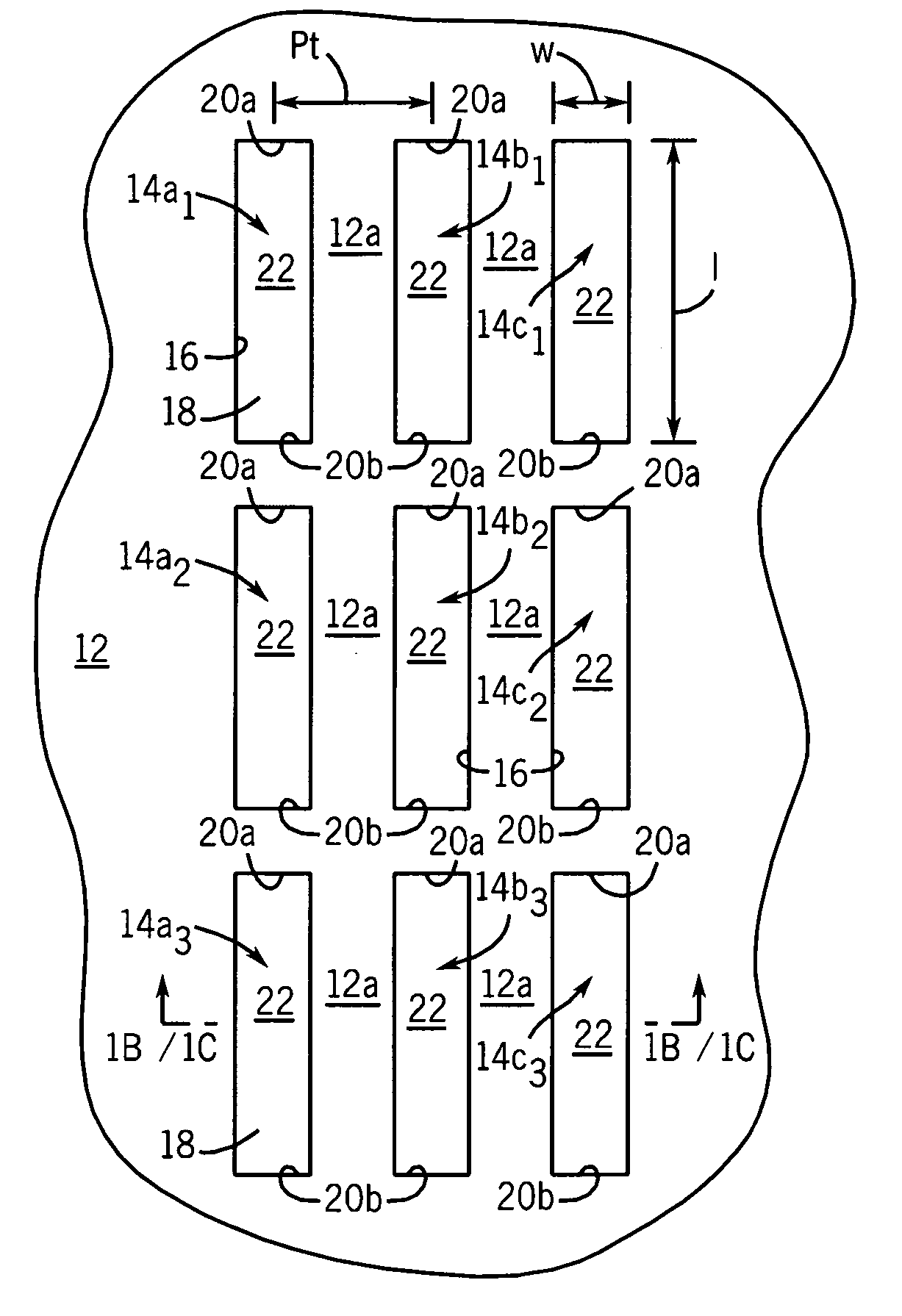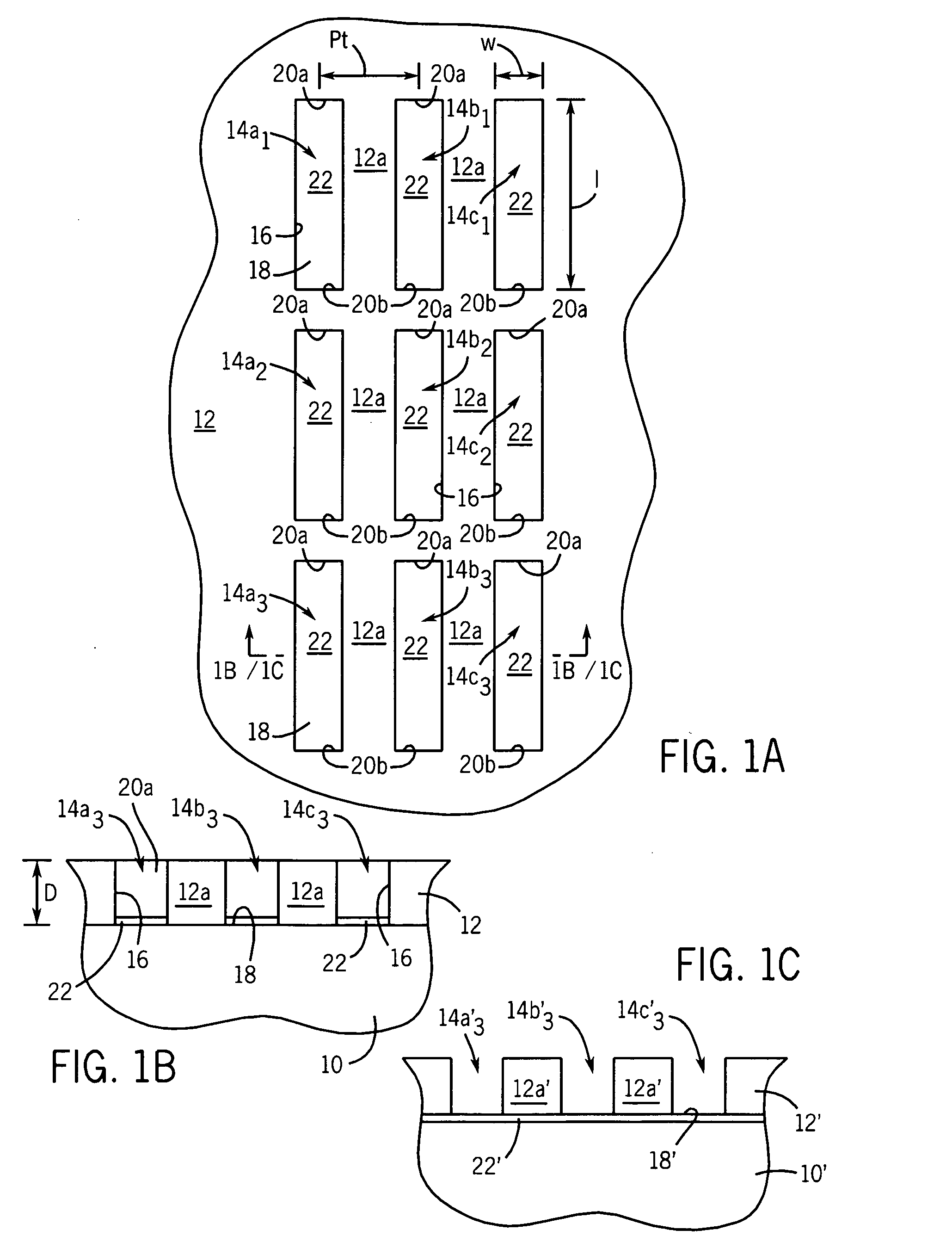Two-dimensional arrays of holes with sub-lithographic diameters formed by block copolymer self-assembly
a self-assembly and block copolymer technology, applied in the direction of ohmic resistance heating, library creation, transportation and packaging, etc., can solve the problems of not being able to address the ordering of domains over a large area, not being able to control the location and orientation of ordered domains, and not being able to accommodate the fabrication of structures and features at the nanometer level
- Summary
- Abstract
- Description
- Claims
- Application Information
AI Technical Summary
Problems solved by technology
Method used
Image
Examples
example 1
[0071]Trenches 250 nm deep with widths ranging from 75 nm to 600 nm having silicon oxide sidewalls and silicon oxycarbide floors were provided. On several of the wafers, oxide was deposited onto the sidewalls and the trench floors. Both types of trench floors were treated to be neutral wetting to PS and PMMA.
[0072]To get perpendicular cylinders, a random PS:PMMA copolymer solution (about 58% PS) containing a crosslinking agent was cast as a film of about 5-10 nm thick onto the features, and annealed at about 160° C. for 4 hours. Capillary forces pulled the PS-r-PMMA to the trench floor prior to complete cross-linking, leaving oxide sidewalls that were preferential-wetting to PMMA. The resulting trench structure had sidewalls that were preferential wetting with the random copolymer layer as a mat on the bottom of the trenches, which provided a neutral wetting surface.
[0073]A 0.425% solution of cylinder-forming PS-b-PMMA in toluene was then cast onto the treated substrates so as to fo...
example 2
[0075]Ternary blends (10-40%) of homopolymers (20 K PS, 20 K PMMA) were prepared in 0.425% solutions of 46K / 21K PS-b-PMMA in toluene. These solutions were cast onto the substrates described above at thicknesses of 30-40 nm. The addition of homopolymers swells the domain sizes of the two fractions, resulting in an increased inherent pitch value (Lo) of the polymer.
[0076]At 10-20% homopolymers, a two row zigzag pattern of cylinders was formed as seen by SEM. With 30% homopolymers content, the zigzag pattern began to break down and numerous errors and unusual morphologies were observed. When a ternary blend of 46 / 21 PS-b-PMMA block copolymer with 40% 20 PS and 20K PMMA homopolymers was cast and annealed onto the same substrate (i.e., 80 nm wide trenches, (P(S-r-BCB-r-MMA)) floor, oxide sidewalls), single rows of perpendicular cylinders with apparent diameter of about 35 nm formed in the 80 nm wide trenches. At 40% homopolymers, the mixture caused a pitch of about 50 nm, resulting in th...
PUM
| Property | Measurement | Unit |
|---|---|---|
| width | aaaaa | aaaaa |
| length | aaaaa | aaaaa |
| length | aaaaa | aaaaa |
Abstract
Description
Claims
Application Information
 Login to View More
Login to View More - R&D
- Intellectual Property
- Life Sciences
- Materials
- Tech Scout
- Unparalleled Data Quality
- Higher Quality Content
- 60% Fewer Hallucinations
Browse by: Latest US Patents, China's latest patents, Technical Efficacy Thesaurus, Application Domain, Technology Topic, Popular Technical Reports.
© 2025 PatSnap. All rights reserved.Legal|Privacy policy|Modern Slavery Act Transparency Statement|Sitemap|About US| Contact US: help@patsnap.com



